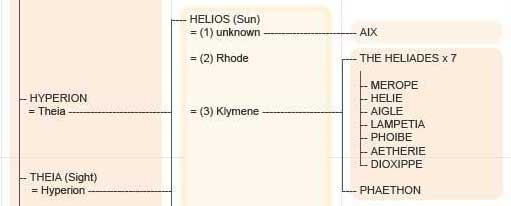|
This is a KEY to the reading of the family charts. The trees should be relatively easy to follow for those familiar with the gods of myth. In short, each generation is placed in a seperate column, from left (oldest) to right (youngest). Siblings are enclosed by solid blocks of colour.
For a detailed description of a character on the chart, refer to the Encyclopedia (Encyc. link left) and click on the character's name. Each entry is accompanied by a broad selection of quotes from classical literature, and many contain images from classical art for illustration.
OVERVIEW OF CHARTS 0 TO 8
These 8 interlinking Charts describe the family tree of the gods. A full list of names with chart and grid references appears on the Index page.
The different Charts encompass these sections of the divine family tree:
Chart 0 Overview of the main gods
Chart 1 The Protogenoi (Primeval Gods)
Chart 2 The Children of Night (Spirits)
Chart 3 The Children of Heaven (Titan Gods, their descendants & siblings)
Chart 4 The Children of Sea, Storm & Earth (Sea-Gods, Monsters, Giants)
Chart 5 The Gods of Olympos (The Twelve Olympians and their family)
Chart 6 The Okeanides (Daughters of Okeanos)
Chart 7 The Rivers & Nymphs 1 (African, Asian & NE European rivers & nymphs)
Chart 8 The Rivers & Nymphs 2
(Greek and Italian rivers & nymphs)
OVERVIEW OF CHARTS HES & HOM
These are stand-alone charts describing the genealogies of the gods as given by Hesiod in his Theogony and Homer in his Iliad and Odyssey.
FAMILY RELATIONS
The family relations are on the chart should be quite self-explanatory. Each column represents one generation, descending from left to right. Lines link parents to their offspring.
EXAMPLE 1

The following extract from Tree 3 should be read as follows:
Hyperion consorts with Theia, and Theia with Hyperion. The two are brother and sister.
Theia's name means sight.
Their first child is Helios whose name is the Greek word for the sun.
Helios consorts with three female divinities.
The first of these, whose name is unknown, produces a child named Aix.
The second, Rhode, is an important divine consort of Helios. However the pair produce no divine children (their mortal sons are not listed on this chart of divine beings).
The third consort, Klymene, bears Helios the seven Heliades and Phaethon.
The Heliades are named Merope, Helie, Aigle, Lampetia, Phoibe, Aetherie, and Dioxippe.
EXAMPLE 2

This extract from Chart 3 can be read as follows.
Koios and Phoibe are brother and sister.
Koios consorts with Phoibe, and Phoibe with Koios. The pair produce two children, named Asteria and Leto. Lelantos may also be their child, however this is not expressly stated in any source (rather it is a scholarly deduction).
Asteria consorts with Perses and produces a child (not shown in this extract of the chart).
Leto consorts with Zeus. Their children appear on another chart, listed with Zeus in the family trees. The reference 5, B11 indicates they can be found on Chart 5, column B, row 11.
Lelantos consorts with Periboia. They produce a child named Aura whose name means the breeze.
Aura, in turn, consorts with Dionysos. They have offspring, who are listed with their father Dionysos on Chart 5, grid C17.
CHART COLOUR BLOCKS
These are simply used for graphical clarity. A block contains a set of siblings (brothers and sisters). The colours alternate by generation (pink in one row, orange in the next).
A lighter block within a block is used to enclose a god with many consorts, such as Zeus who in Chart 5 has 20 partners.
CHART MAP REFERENCES
Common map notations are used in the Index of Names to describe the location of individuals on the charts.
On the tree charts an arrow pointing right from a character to such a reference indicates that their descendants are listed elsewhere on the tree. Mostly these are females whose descendants appear beside the father.
EXAMPLE
5, B6 ........ refer to Chart 5, grid B6 (column B, row 6)
C12 .......... on the same chart refer to column C, row 12
CHART NOTATIONS
Name [m]
The [m] indicates a mortal man or woman (because this is a family tree of divine beings, mortal men and women usually only appear as consorts of gods and goddesses).
? NAME
The genealogy of this character on the tree is unknown, however they likely belong here on the family chart.
= Name
A
consort of the character. This may or may not be the individual's husband or wife. Many of the unions are simply sexual couplings which produce offspring.
= (1) Name
= (2) Name
The divinity has multiple consorts. Only divine children appear on the chart. A mortal consort of a god who produces only mortal offspring is not listed as a consort on the chart.
|